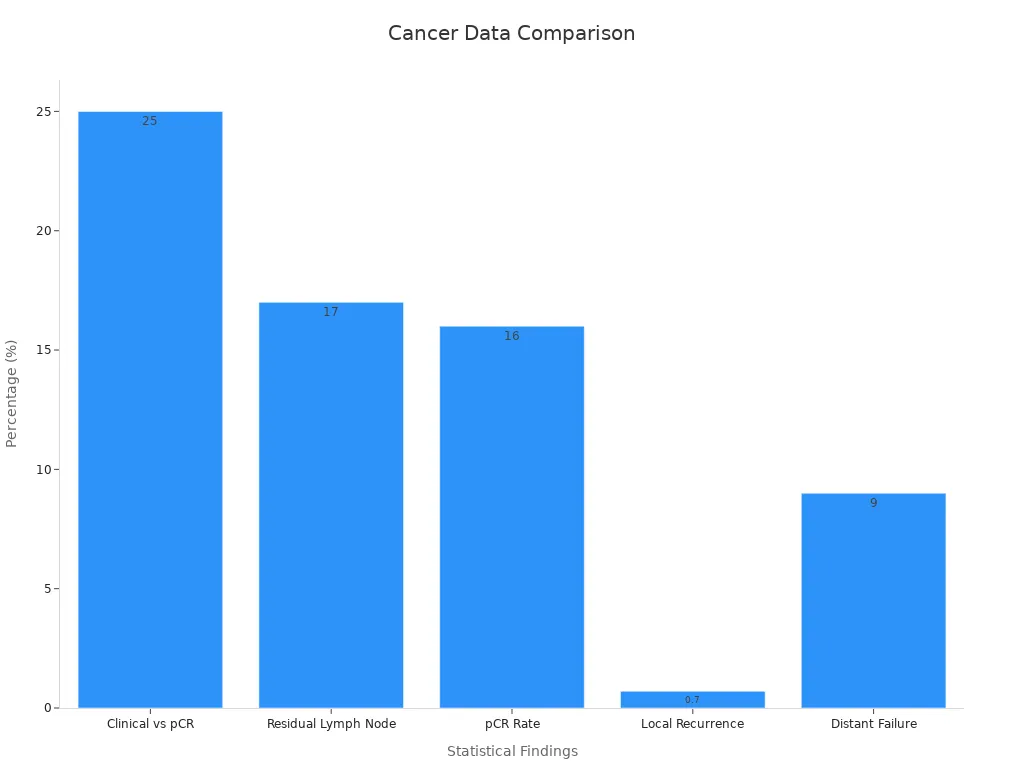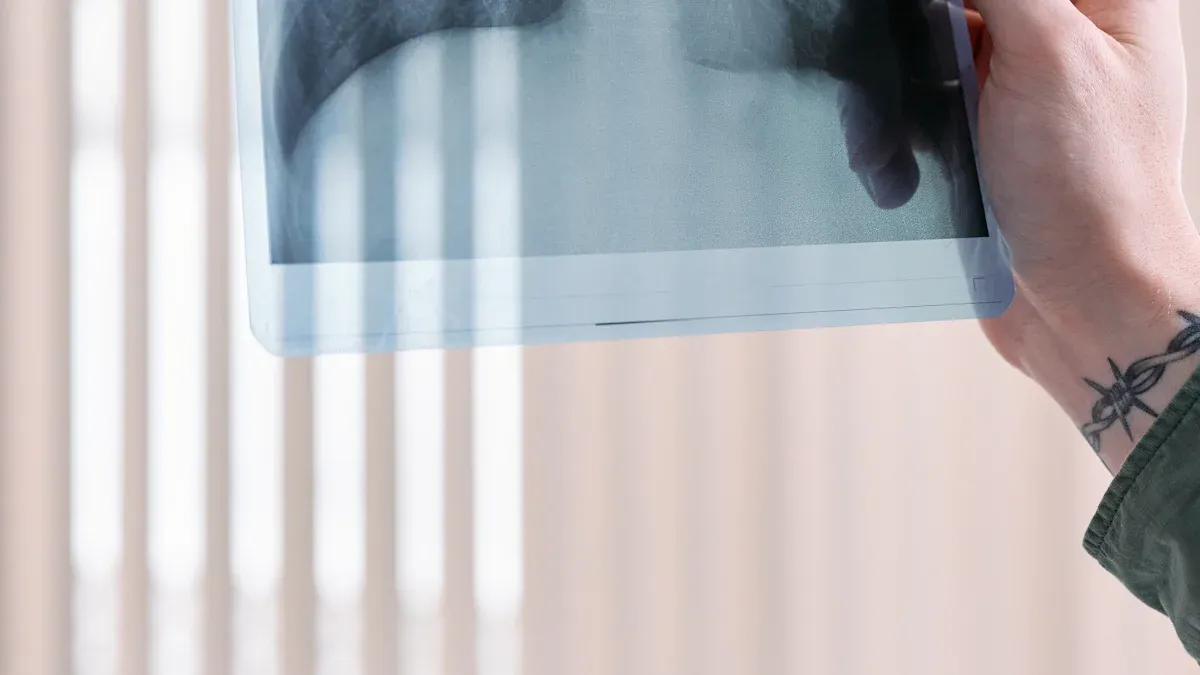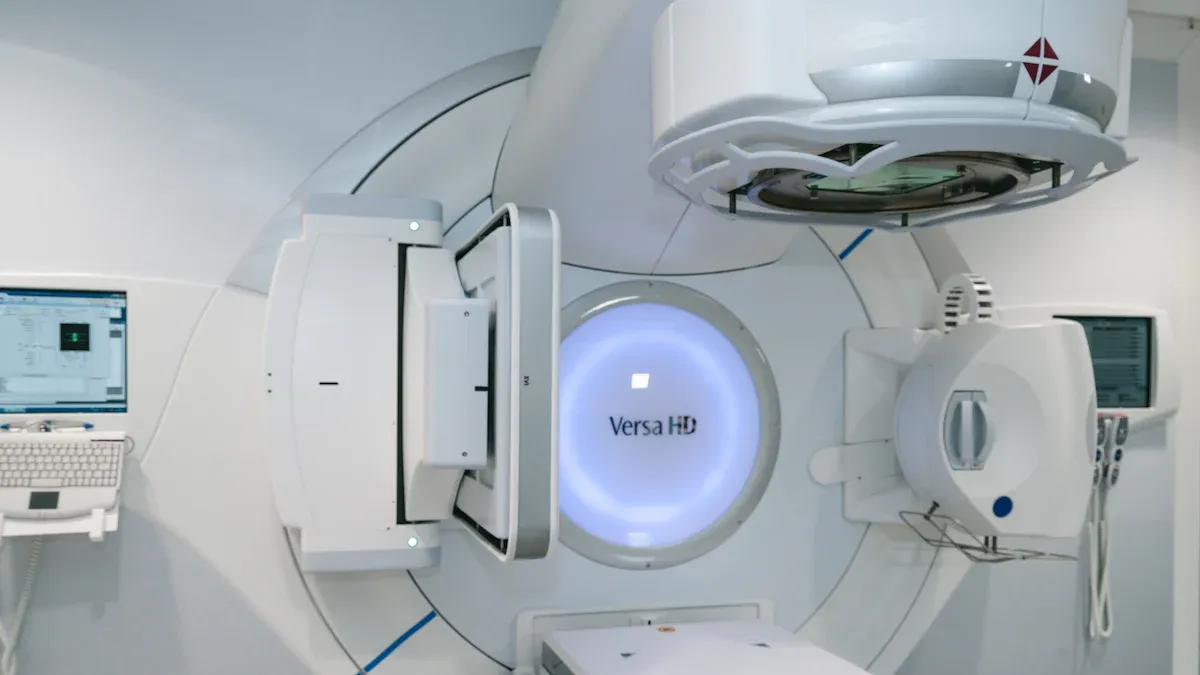Why tumor shrinkage does not always mean cancer is gone

Many people believe that when a tumor shrinks, the cancer has disappeared. This idea can give you hope, but it does not always match what happens inside your body. Tumor shrinkage doesn't mean cancer is gone -Myth: Shrinkage indicates complete cancer eradication. Even after doctors see a tumor get smaller on scans, cancer cells may still remain. For example, only about 25% of patients who look cancer-free after treatment actually have no cancer cells left when doctors check more closely. You can see how these numbers compare in the chart below:

Doctors use regular check-ups and tests to watch for any hidden cancer cells. Staying alert helps you understand your treatment results and keeps you safe.
Key Takeaways
Tumor shrinkage shows treatment is working but does not mean all cancer cells are gone.
Some cancer cells can hide, resist treatment, or stay dormant, making them hard to detect and kill.
Remission means cancer is under control but not always cured; regular check-ups remain essential.
Follow-up tests help find hidden cancer cells early and guide future treatment decisions.
Staying proactive with your care and asking questions improves your chances for long-term health.
Tumor Shrinkage Doesn't Mean Cancer Is Gone

Myth: Shrinkage Indicates Complete Cancer Eradication
Many people think that if a tumor gets smaller, all the cancer is gone. This is a common misunderstanding. Tumor shrinkage doesn't mean cancer is gone -Myth: Shrinkage indicates complete cancer eradication. When you see a tumor shrink on a scan, you might feel hopeful. However, doctors know that some cancer cells can still hide in your body, even when the main tumor looks much smaller.
You may wonder how often this happens. Doctors have studied patients who received different treatments. The table below shows what they found:
Parameter | GCS Arm (Gemcitabine+Cisplatin+S-1) | GC Arm (Gemcitabine+Cisplatin) |
|---|---|---|
Percentage of patients in categories A (< -30% tumor size) and B (-30% to 0%) | 67% (61 patients) | 36% (33 patients) |
Maximum tumor shrinkage in category A | -53% | -65% |
Time to maximum tumor response (days) in category A | 165 ± 76 | N/A |
Time to maximum tumor response (days) in category B | 139 ± 78 | N/A |
Percentage of patients experiencing tumor regrowth after treatment | 20% | N/A |
Average time to tumor regrowth (days) | 154 ± 143 | N/A |
This table shows that even when tumors shrink by more than half, about 20% of patients see their tumors grow back. Tumor shrinkage doesn't mean cancer is gone -Myth: Shrinkage indicates complete cancer eradication. You need to remember that a smaller tumor does not always mean the cancer has disappeared.
Tip: Always ask your doctor what your scan results really mean. Tumor shrinkage is good news, but it is not the end of the story.
What Shrinkage Really Shows
When you look at your scan results, you might see words like "partial response" or "stable disease." These terms help doctors describe what is happening inside your body. Tumor shrinkage doesn't mean cancer is gone -Myth: Shrinkage indicates complete cancer eradication. A partial response means your tumor has shrunk by at least 30%, but it has not vanished. Complete response means all signs of the tumor are gone on the scan. Stable disease means the tumor has not grown or shrunk enough to fit the other categories.
Doctors use special rules to decide which category you fit into. For example, the RECIST 1.1 criteria say that a partial response is a decrease of at least 30% in the size of the tumor. Complete response means the tumor cannot be seen at all. If the tumor grows by 20% or more, or if new tumors appear, doctors call this disease progression. Sometimes, doctors use other tests to check how active the cancer cells are. If the cancer cells stop using sugar, this can mean a complete metabolic response. If they use less sugar, this is a partial metabolic response.
Imaging tests like CT scans and PET scans help doctors see tumors, but these tests have limits. Tiny groups of cancer cells can hide and not show up on scans. Tumor shrinkage doesn't mean cancer is gone -Myth: Shrinkage indicates complete cancer eradication. You need to keep this in mind when you look at your results.
Partial response: Tumor shrinks by at least 30%, but not gone.
Complete response: Tumor disappears on scans.
Stable disease: Tumor does not change much.
Progression: Tumor grows or new tumors appear.
You should understand that even if your tumor shrinks, some cancer cells may still be present. This is why doctors keep checking you after treatment. Tumor shrinkage doesn't mean cancer is gone -Myth: Shrinkage indicates complete cancer eradication. Regular follow-up helps catch any changes early.
Why Some Cancer Cells Survive
Resistant and Hidden Cells
You might think that cancer treatment destroys every cancer cell in your body. In reality, some cancer cells can survive, even after strong treatments like chemotherapy or radiation. These cells can resist drugs or hide from your immune system. This makes them very hard to find and kill.
Cancer cells use many tricks to survive:
They can change their shape or lose certain markers, making it harder for your immune system to spot them.
Some cancer cells turn off the signals that help your body recognize them as threats.
They can create a protective environment around themselves, blocking immune cells from getting close.
Cancer cells sometimes enter a "sleep mode" called dormancy. In this state, they stop dividing and become invisible to treatments that target growing cells.
Some cells act like stem cells. These cancer stem cells can repair themselves and start new tumors later.
Note: Chemotherapy and radiation mostly target cells that are dividing quickly. Dormant cancer cells do not divide, so they often escape these treatments.
Researchers have found that even when scans look clear, tiny groups of cancer cells may still remain. For example, a study on breast cancer patients showed that people with small lesions left on MRI scans after treatment had a much lower chance of complete response. Only 14% of these patients had no cancer left when doctors checked under a microscope, compared to 39% of patients whose scans looked completely clear. In multiple myeloma, experts have seen that cancer cells can hide in the bone marrow or other parts of the body. Imaging tests sometimes miss these hidden cells, which means the cancer can return later.
Scientists have also discovered special "persister cells" in many types of cancer. These cells survive treatment by entering a dormant state. They do not need new mutations to resist drugs. Instead, they change how they work inside. In lab studies, targeting certain enzymes in these persister cells stopped tumors from coming back in mice. This gives hope for new treatments that could wipe out even the most stubborn cancer cells.
You should know that cancer is not just one disease. Tumors contain many different types of cells. Some cells may already have mutations that help them survive treatment. Others may develop resistance over time. This mix of cells makes it hard to kill every last one.
Cancer cells can:
Hide from your immune system by changing their surface proteins.
Use epigenetic changes to turn off genes that would make them visible.
Create a microenvironment that blocks immune attacks.
Enter dormancy and avoid detection.
Survive as cancer stem cells and start new tumors.
Risk of Recurrence
Even if your scans look perfect, you still face a risk that cancer could come back. Doctors call this a "recurrence." The main reason is that some cancer cells may remain in your body after treatment. These cells are too small to see on scans or tests, but they can start growing again later.
Doctors use special tests to look for minimal residual disease (MRD). MRD means a tiny number of cancer cells are still present after treatment. These cells can cause cancer to return months or even years later. For example, in early breast cancer, a blood test called ctDNA can find traces of cancer before you feel sick or see anything on a scan. In one study, ctDNA detected cancer recurrence up to 18 months before doctors found it with regular tests.
Here is a table showing how MRD tests help predict cancer recurrence:
Cancer Type | MRD Marker | What It Shows | Value/Result |
|---|---|---|---|
Early Breast Cancer | ctDNA detection | Sensitivity for recurrence | |
Early Breast Cancer | ctDNA lead time | Time before clinical recurrence | 3.4 to 18.5 months |
Early Breast Cancer | ctDNA in healthy | False positives in recurrence-free patients | 0/13 |
NSCLC (lung cancer) | MRD negativity | Predicts cure (Negative Predictive Value) | >95% over 18 months |
NSCLC (lung cancer) | MRD positivity | Higher risk of recurrence |
Tip: MRD tests are powerful, but not perfect. Sometimes, they miss cancer cells or give false alarms. Doctors use these tests along with scans and regular check-ups to watch for recurrence.
You should remember that cancer cells can change and adapt. Some may become resistant to drugs during treatment. Others may hide in places where tests cannot reach. Over time, these cells can wake up, start dividing, and form new tumors. This is why you need regular follow-up visits, even if you feel healthy and your scans look good.
Doctors and scientists continue to study how cancer cells survive and return. They hope to find better ways to detect and destroy every last cancer cell. For now, staying alert and following your care plan gives you the best chance to catch any problems early.
Remission vs. Cure

What Is Remission?
You may hear your doctor say you are "in remission" after cancer treatment. Remission means your cancer has responded to treatment or is under control. Doctors use clear criteria to decide if you are in remission:
You have fewer or no signs and symptoms of cancer.
Partial remission means your tumor shrinks by at least 30%.
Complete remission means doctors cannot find any cancer with scans or tests.
Remission must last at least one month to count as clinical remission.
Even in complete remission, tiny cancer cells may still hide in your body.
Remission Type | What It Means | How Doctors Check |
|---|---|---|
Complete Remission | Imaging, blood tests, exams | |
Partial Remission | Tumor shrinks by 30-50%, but some cancer remains | Imaging, blood tests |
Duration | Remission can last weeks, months, or years | Ongoing monitoring |
Doctors may use words like "no evidence of disease" (NED) when they cannot find cancer. This does not always mean you are cancer-free. Some cancer cells may be too small to detect. Your doctor will keep checking you with scans or blood tests to watch for any changes.
Note: Remission can last a short or long time. You may need more treatment during remission, or you may not.
Cure and Long-Term Outlook
You might wonder if remission means you are cured. A cure means your cancer is gone, you do not need more treatment, and doctors do not expect it to return. Doctors need time to confirm a cure because cancer can come back years later. Most doctors wait several years before using the word "cure."
Long-term studies show that survival rates improve over time for many cancers. For example, thyroid cancer has a 20-year survival rate of over 95%. Melanoma, germ cell tumors, and Wilms’ tumor also have high long-term survival rates. Breast cancer survival drops from about 86% at five years to 70% at twenty years. Colorectal cancer survival goes from 61% at five years to 50% at twenty years. Most deaths happen early, so if you stay cancer-free for several years, your chance of cure increases.
Researchers found that for some cancers, like nasopharyngeal carcinoma, it takes about 5 to 7 years to reach a 95% chance of cure. Your age, cancer type, and how well you respond to treatment all affect your outlook.
Tip: Staying in remission for many years gives you a better chance of being cured, but regular check-ups remain important. Your doctor will guide you on what to expect and how to stay healthy.
Ongoing Monitoring Matters
Follow-Up Tests
After your treatment, you need regular follow-up tests. These tests help your doctor find any cancer cells that might remain in your body. Imaging scans, such as CT scans, play a key role. They let your doctor see if your tumor has changed in size or if new growths have appeared. The RECIST guidelines and other criteria, like Choi and MASS, guide doctors on how to measure and track tumors over time. Studies show that even a 10% shrinkage on early follow-up scans can predict how well you will do, especially in cancers like metastatic renal cell carcinoma.
Doctors also use blood tests to look for tiny traces of cancer. For example, a test called ctDNA checks for cancer DNA in your blood. If ctDNA remains after treatment, you have a higher risk of cancer coming back. In early-stage lung cancer and triple-negative breast cancer, ctDNA can signal relapse before scans show any changes. Newer tests, such as the TARDIS blood test, can find very small amounts of cancer DNA. These tests help your doctor decide if you need more treatment, even when scans look normal.
Key reasons for follow-up tests:
Detect hidden cancer cells
Track tumor changes over time
Guide future treatment decisions
Find side effects from therapy early
Tip: Always ask your doctor what each test checks for and how often you need them.
Staying Proactive
You play a big part in your long-term health. Cancer care does not end when treatment stops. You need to stay alert and keep up with your follow-up visits. Cancer is now managed as a chronic disease for many people, with more than half living five years or longer after diagnosis. Regular follow-up helps your doctor catch problems early, manage side effects, and support your recovery.
Early detection of recurrence allows for quick action, such as surgery or new medicines.
Follow-up visits give you a chance to talk about symptoms, side effects, or worries.
Supportive care during follow-up helps with emotional health and daily life.
Some clinics use phone calls or nurse-led visits, which can be as helpful as hospital visits.
Staying proactive with your care gives you the best chance for a healthy future. Keep asking questions and share any changes you notice with your healthcare team.
You play a key role in your health after cancer treatment. Stay alert with regular follow-up visits and talk openly with your healthcare team. Tumor shrinkage doesn't mean cancer is gone -Myth: Shrinkage indicates complete cancer eradication. Knowing the difference between tumor shrinkage, remission, and cure helps you set realistic goals and make better choices. Experts explain that understanding these terms leads to better long-term outcomes because it helps you manage cancer as a chronic illness and improves your chances for survival.
FAQ
What does it mean if my tumor shrinks after treatment?
Tumor shrinkage shows your treatment is working. You still need regular check-ups. Some cancer cells may remain, even if the tumor gets smaller.
Can a tumor disappear on scans but still come back?
Yes. Scans cannot always find every cancer cell. Some cells may hide or stay dormant. You need ongoing monitoring to catch any changes early.
Why do I need follow-up tests if my scans look clear?
Follow-up tests help your doctor find hidden cancer cells. These tests can catch problems before you feel sick. Staying on schedule with tests gives you the best chance for early treatment.
Does tumor shrinkage mean I am cured?
No. Tumor shrinkage is a good sign, but it does not mean you are cured. You may still have cancer cells in your body. Your doctor will watch you closely for several years.
See Also
Essential Facts Everyone Needs To Understand Carcinoid Tumors
A Comprehensive Guide To The Main Features Of Glioblastoma
Recognizing Symptoms And Treatment Options For Duodenal Cancer
